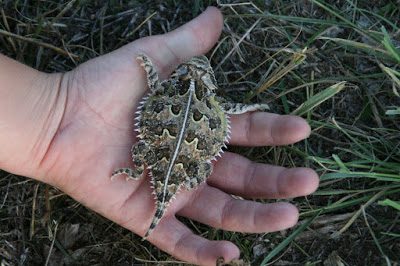For the past ten years I have counted horny toads for Texas Parks and Wildlife. Okay, so they they really aren’t toads, nor frogs (sorry, TCU people); they are lizards. I know that. But I grew up calling them horny toads, as I suspect, nearly everyone else in Texas did and still do. So even though I am an official tracker for the Texas Horned Lizard Watch, they will always be horny toads to me. What a tracker does is pick a site, visit it at least three times from April to September, and report on the number of horny toads seen at the time. Parks and Wildlife then compiles the information to learn what they can about the current population numbers, where horny toads still live, what they eat, and causes for the decrease in their numbers.

Why the decrease in population? Well, there are several reasons. Horned lizards eat red harvester ants. Imported fire ants drive away the harvester ants, and the lizards won’t eat the imported fire ants. So that hurts them. But just plain old civilization has caused a loss of habitat for the little critters as well. And then of course, trying to keep them as pets and doing mean things to them doesn’t help either.
Don’t move a horny toad to a new location, thinking you are making him safer. Research has shown that they are territorial and memorize, if you will, the location of the ant beds in their area, and if a well-meaning person moves one out of its area, it will most likely starve to death before it finds another ant bed.
The coolest thing the big guys do to study horny toads is to outfit them with the cutest, tiniest little backpacks loaded with a tracking device and then map their movements. This technique led to the discovery that horny toads will actually climb up low branches or trunks of trees to get out of the summer heat on dry, hard, sandy ground in South Texas. Really. Of course, that was not what the researchers set out to discover, but it was a neat surprise nonetheless. What the tracking does tell them is information about movement and territory of the lizards. And other stuff that I don’t remember all the details about.
This year I saw a bumper crop of four newborn horny toads, which may not sound like a big deal to you, but it is. Most years I don’t see any little ones, so this is major. And they are soooo cute! And tiny. Which may be why I don’t see many-they are so bloomin’ hard to see. Counting them all, I saw eleven lizards this year, a record number for me, as I recall. I went out more than the required three times, but I didn’t see one every time I went looking. But eleven is a good number.
So if you would like to look for horny toads, contact Texas Parks and Wildlife and you, too, can amaze your friends and impress your enemies when they learn that you are an official horned lizard tracker.
Recent Comments